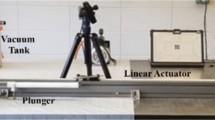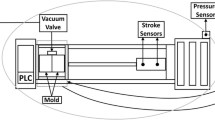Abstract
Shrinkage porosity is one of the most common defects leading to rejection in high-pressure die-casting (HPDC). As the metal solidifies, it contracts and shrinks in volume. If the cooling rate is too rapid or the metal is not sufficiently fluid, the shrinkage rate can exceed the rate of metal flow into the cavity, resulting in the formation of porosity. Shrinkage porosity appears as a network of small voids or pores, which can reduce the strength and integrity of the final product. This study aims to investigate the comparative effects of process parameters on shrinkage defects in HPDC. Our methodology focuses on examining four distinct casting models under various casting conditions, such as changes in molten metal injection temperature, injection speed. Despite the identified influence of these process parameters, it was observed that the part geometry plays a significant role in dictating the degree of shrinkage. While our results validate the effects of process parameters on shrinkage defects, it demonstrates the predominant role of the casting geometry. We employ the secondary dendrite arm spacing and dimensionless Niyama criteria for predicting shrinkage defects, verifying our simulation data with empirical evidence from an in-process-embedding sensor-equipped casting machine. The results reveal a clear correlation between the processing parameters and shrinkage once a specific geometry is established. Within a given geometry, the extent of shrinkage defects follows a pattern determined by the processing conditions.














Similar content being viewed by others
References
H. Pinto, F. Silva, Optimisation of die casting process in Zamak alloys. Procedia Manuf. 11, 517–525 (2017). https://doi.org/10.1016/j.promfg.2017.07.145
E.J. Vinarcik, High Integrity Die Casting Processes. Wiley (2002)
C. Herrmann, T. Heinemann, S. Thiede, Synergies from process and energy oriented process chain simulation—a case study from the aluminium die casting industry, in Glocalized Solutions for Sustainability in Manufacturing (Springer, 2011), pp. 317–322
K.C. Apparao, A.K. Birru, Optimization of Die casting process based on Taguchi approach. Mater. Today: Proc. 4(2), 1852–1859 (2017). https://doi.org/10.1016/j.matpr.2017.02.029
Y. Otsuka, Experimental verification and accuracy improvement of gas Entrapment and shrinkage porosity simulation in high pressure die casting process. Mater. Trans. 55(1), 154–160 (2014). https://doi.org/10.2320/matertrans.f-m2013835
D. Mery, T. Jaeger, D. Filbert, A review of methods for automated recognition of casting defects. Insight-Wigston Then Northampton- 44(7), 428–436 (2002)
F. Bonollo, N. Gramegna, G. Timelli, High-pressure die-casting: contradictions and challenges. JOM 67(5), 901–908 (2015). https://doi.org/10.1007/s11837-015-1333-8
E. Niyama, A method of shrinkage prediction and its application to steel casting practice. Imono 54(8), 507–517 (1982)
K.D. Carlson, C. Beckermann, Use of the Niyama criterion to predict shrinkage-related leaks in high-nickel steel and nickel-based alloy castings, in 62nd SFSA Technical and Operating Conference (2008)
M. Kang et al., Prediction of microporosity in complex thin-wall castings with the dimensionless Niyama criterion. Materials 6(5), 1789–1802 (2013). https://doi.org/10.3390/ma6051789
C. Monroe, C. Beckermann, Prediction of hot tearing using a dimensionless Niyama criterion. JOM 66(8), 1439–1445 (2014). https://doi.org/10.1007/s11837-014-0999-7
S. Polyakov, A. Korotchenko, J. Bast, Use of the Niyama criterion to predict porosity of the mushy zone with deformation. Arch. Found. Eng. 11(4), 131–136 (2011)
F.R. Mollard, M.C. Flemings, E.F. Niyama, Aluminum fluidity in casting. JOM 39(11), 34–34 (1987). https://doi.org/10.1007/bf03257537
K.D. Carlson, C. Beckermann, Prediction of shrinkage pore volume fraction using a dimensionless Niyama criterion. Metall. Mater. Trans. A 40(1), 163–175 (2009). https://doi.org/10.1007/s11661-008-9715-y
N.T. Trí, Using Dimensionless Niyama Criterion to Predict Shrinkage Porosity (Tạp chí Khoa học và Công nghệ-Đại học Đà Nẵng, 2016), pp. 62–66
R.A. Hardin, C. Beckermann, Prediction of the fatigue life of cast steel containing shrinkage porosity. Metall. Mater. Trans. A 40(3), 581–597 (2009). https://doi.org/10.1007/s11661-008-9755-3
C. Ma et al., The effect of slow shot speed and casting pressure on the 3D microstructure of high pressure die casting AE44 magnesium alloy. J. Magn. Alloys (2021). https://doi.org/10.1016/j.jma.2021.09.011
Z. Weishan, X. Shoumei, L. Baicheng, Study on a CAD/CAE system of die casting. J. Mater. Process. Technol. 63(1–3), 707–711 (1997). https://doi.org/10.1016/s0924-0136(96)02711-2
M. Okayasu et al., A study of the mechanical properties of an Al–Si–Cu alloy (ADC12) produced by various casting processes. Mater. Sci. Eng. A 543, 185–192 (2012)
M. Okayasu et al., Influence of microstructural characteristics on mechanical properties of ADC12 aluminum alloy. Mater. Sci. Eng. A 592, 189–200 (2014)
S. Janudom et al., Feasibility of semi-solid die casting of ADC12 aluminum alloy. Trans. Nonferr. Met. Soc. China 20(9), 1756–1762 (2010)
L.Q. Tang, C. Chassapis, S. Manoochehri, Optimal cooling system design for multi-cavity injection molding. Finite Elem. Anal. Des. 26(3), 229–251 (1997). https://doi.org/10.1016/s0168-874x(96)00083-2
J.-Z. Liang, An optimal design of cooling system for injection mold. Polym. Plast. Technol. Eng. 41(2), 261–271 (2002)
C. Xu et al., Cooling rate and microstructure of rapidly solidified Al–20 wt.% Si alloy. Mater. Sci. Eng. A 417(1–2), 275–280 (2006). https://doi.org/10.1016/j.msea.2005.10.040
S. Park, T. Kwon, Thermal and Design Sensitivity Analyses for Cooling System of Injection Mold, Part 1: Thermal Analysis (1998)
X.-Y. Qin et al., Finite element analysis for die casting parameters in high-pressure die casting process. China Found. 16(4), 272–276 (2019). https://doi.org/10.1007/s41230-019-8088-8
A. Sakhuja, J.R. Brevick, Prediction of thermal fatigue in tooling for die‐casting copper via finite element analysis, in AIP Conference Proceedings (American Institute of Physics, 2004)
Z. Chen, M. Jahedi, Die erosion and its effect on soldering formation in high pressure die casting of aluminium alloys. Mater. Des. 20(6), 303–309 (1999)
G. Dour et al., Development of a non-intrusive heat transfer coefficient gauge and its application to high pressure die casting: effect of the process parameters. J. Mater. Process. Technol. 169(2), 223–233 (2005). https://doi.org/10.1016/j.jmatprotec.2005.03.026
M. Barone, D. Caulk, Analysis of liquid metal flow in die casting. Int. J. Eng. Sci. 38(12), 1279–1302 (2000)
J. Zheng et al., Optimization of high-pressure die-casting process parameters using artificial neural network. Int. J. Adv. Manuf. Technol. 44(7), 667–674 (2009). https://doi.org/10.1007/s00170-008-1886-6
Y. Woon, K. Lee, Development of a die design system for die casting. Int. J. Adv. Manuf. Technol. 23(5), 399–411 (2004)
Acknowledgements
This work was supported by the Technology Innovation Program (20016443) funded By the Ministry of Trade, Industry & Energy (MOTIE, Korea).
Author information
Authors and Affiliations
Corresponding author
Ethics declarations
Conflict of interest
On behalf of all authors, the corresponding author states that there is no conflict of interest.
Additional information
Publisher's Note
Springer Nature remains neutral with regard to jurisdictional claims in published maps and institutional affiliations.
Rights and permissions
Springer Nature or its licensor (e.g. a society or other partner) holds exclusive rights to this article under a publishing agreement with the author(s) or other rightsholder(s); author self-archiving of the accepted manuscript version of this article is solely governed by the terms of such publishing agreement and applicable law.
About this article
Cite this article
Lee, S., Han, D., Kang, S. et al. Method of Predicting Shrinkage Defects and Deriving Process Conditions in HPDC (High-Pressure Die-Casting) for Electric Vehicle Motor Housings. Inter Metalcast 18, 1262–1272 (2024). https://doi.org/10.1007/s40962-023-01100-y
Received:
Accepted:
Published:
Issue Date:
DOI: https://doi.org/10.1007/s40962-023-01100-y




